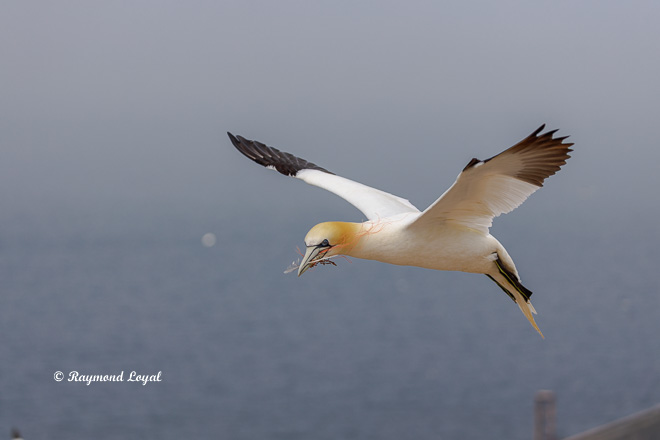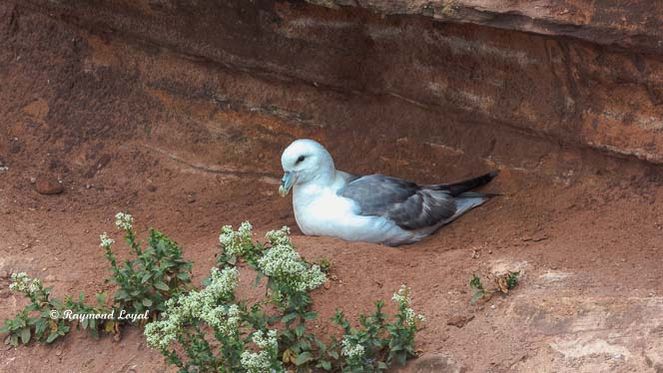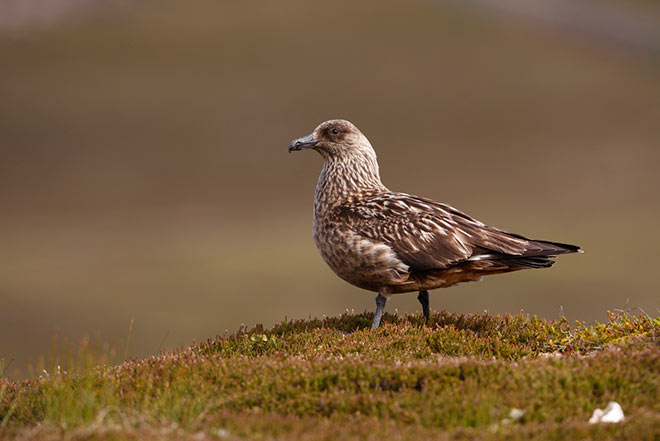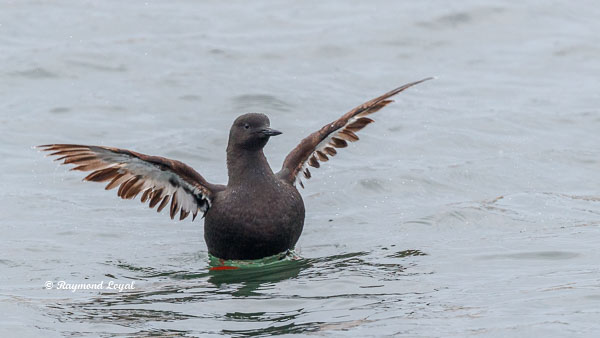Seabirds
Shearwaters - Skuas - Gulls - Terns & Auks
The term seabirds covers a large group of birds of a number of families and genera specilised to live on the open seas, islands and coastal regions of the earth. Some of them spent most of their time out on the Atlantic and only come to the shore during breeding seasons. Many of these species are difficult to identify, especially because of the many different plumages they wear during their immature period. One of the best known group, at least by name, are the seagulls, and problably many people will already have seen seegulls somewhere.

Albatrosses and Gannets
Albatrosses are very large seabirds and mostly are distributed in the Southern Ocean and the North Pacific. They rarely ever appear but are usually absent from the North Atlantic where the Gannet takes their place.
Albatrosses and Gannets have the most efficient flying abilities of all birds on earth. They spent most of their time out on the ocean and only return to land for breeding.

Petrels - Fulmars - Shearwaters and Storm Petrels - "tube-nosed"
Petrels are little dark seabirds with white rump-patches. Usually they can be seen skimming and flitting low over the ocean waves.
Fulmars and Shearwaters have a distinctive flight pattern, they fly with several flaps and a glide, banking on sabre-like wings in the wave-troughs. Fulmars are fairly stout, as compared to petrels and look more like a gull but also fly on stiff wings.
Sharewaters have slender bills, are longer-bodied than the smaller petrels and also have narrow stiff wings.
They all have live out on the ocean and visit land only for breeding. Also they have in common are tube-like external nostrils.
They all nest in holes or on cliff ledges.
The following species live in the West Palearctic and the northern Atlantic:
Order: Procellariiformes
Family: Oceanitidae
- Wilson's Storm Petrel (Oceanites oceanicus)
- White-faced Storm Petrel (Pelagodroma marina)
Family: Hydrobatidae - Storm Petrels
- European Storm Petrel (Hydrobates pelagicus)
- Leach's Storm Petrel (Oceanodroma pelagicus)
- Band-rumped Storm Petrel (Oceanodroma castro)
Family: Diomedeidae - Albatrosses
- Snowy Albatross (Diomedea [exulans] exulans)
- Black-browed Albatross (Thalassarche melanophris)
Family: Procellariidae - Petrels
- Fea's Petrel (Pterodroma faeae)
- Zino's Petrel (Pterodroma madeira)
- Soft-plumaged Petrel (Pterodroma mollis)
- Northern Fulmar (Fulmar [glacialis] glacialis)
- Bulwer's Petrel (Bulweria [bulwerii] bulwerii)
- Great Shearwater (Puffinus gravis)
- Cory's Shearwater (Puffinus diomedea)
- Sooty Shearwater (Puffinus griseus)
- Manx Shearwater (Puffinus [puffinus] puffinus)
- Balearic Shearwater (Puffinus [puffinus] mauretanicus)
- Yelkouan Shearwater (Puffinus [puffinus] yelkouan)
- Macaronesian Shearwater (Puffinus [lhermineri] baroli)
- Antarctic Giant Petrel (Macronectes giganteus)
- Lesser Snow Petrel (Pagodroma nivea)
Family: Sulidae
- Northern Gannet (Morus bassanus)
- Brown Booby (Sula leucogaster)

Skuas
Skuas are large seabirds, they behave rather hawk-like. Their plumage is mostly dark and they have narrow angled wings. Adult skuas usually have elongated central tail feathers. The plumage show variable intermediate and dark phases. All species show flash of white on the wings which is created by whit wing-quills.
Their behaviour is rather parasitical or piratical, they chase other birds for food. They harrass other birds as long as the bird disgorges.
Skuas nest on the ground and sexes are very similar.
Skua species in the West Palearctic are:
- Great Skua (Stercorarius skua)
- Pomarine Skua (Stercorarius pomarinus)
- Parasitic Jaeger (Stercorarius parasiticus)
- Long-tailed Jaeger (Stercorarius longicaudus)
Gulls
Gulls are rather largish and mainly bulky seabirds living on the ocean, the coastline and are also regularly seen on land. They have long wing, are mostly white with grey or black backs and wings and are longer-legged than terns. In flight the tail is usually fanned out.
White headed species show dusky streaks in winter whereas dark-hooded species mainly have white heads in winter. Sexes are similar.
Gulls mainly feed on fish and carrion and also on rubbish.
The Gulls of the Western Palearctic
There are 26 species existing in the Western Palearctic (= Europe, Northern Africa and the Middle East). Only 10 species generally appear in Central Europe, either als breeding birds or migrants. The other species live on the edges of the Palearctic but occasionally appear in Central Europe as rare sightings.
- Black-headed Gull (Larus ridibundus)
- Slender-billed Gull (Chroicocephalus genei)
- Bonarparte's Gull (Chroicocephalus philadelphia)
- Common Gull (Larus canus)
- Ring-billed Gull (Larus delawarensis)
- Mediterranean Gull (Larus melanocephalus)
- European Herring Gull (Larus argentatus)
- American Herring Gull (Larus smithsonianus)
- Yellow-legged Gull (Larus michahellis)
- Armenian Gull (Larus armenicus)
- Audouin's Gull (Larus audouinii)
- Caspian Gull (Larus cachinans)
- Pallas's Gull (Larus ichthyaetus)
- Greater Black-backed Gull (Larus marinus)
- Lesser Black-backed Gull (Larus fuscus)
- Ross's Gull (Rhodostethia rosea)
- Little Gull (Hydrocoloeus minutus)
- Black-legged Kittiwake (Rissa tridactyla)
- Sabine's Gull (Xema sabini)
- Glaucous Gull (Larus hyperboreus)
- Iceland Gull (Larus glaucoides)
- Ivory Gull (Pagophila eburnea)
- Sooty Gull (Larus hemprichii)
- White-eyed Gull (Larus leucophthalmus)
- Laughing Gull (Larus atricilla)
- Franklin's Gull (Larus pixican)
Terns - Sternidae
Upon first look terns seem to resemble gulls, but they do not. Terns are small to medium birds. They are much smaller and slimmer than gulls and also have narrow wings, very much in contrast to the broader winged gulls. In flight they are very agile and graceful. The bills are slender and more sharply pointed than is the case with gulls. During flight the bill is mostly carried downward. And one of the most obvious and best identification features at all is the forked tail
Other important features, helpful to memorize for later use, are the whitish plumage; they have black caps during summer and in winter foreheads are white. We can watch them hovering over water and then suddenly drop into water to catch a fish. In stark contrast to gulls they are not very good at walking.
The species we can find in the Western Palearctic are:
- Brown Noddy (Anous stolidus)
- Sooty Tern (Onychoprion fuscata)
- Bridled Tern (Onychoprion anaethetus)
- Little Tern (Sternula albifrons)
- Gull-billed Tern (Gelochelidon nilotica)
- Caspian Tern (Hydroprogne caspia)
- Whiskered Tern (Chlidonias hybrida)
- White-winged Tern (Chlidonias leucopterus)
- Black Tern (Chlidonias niger)
- Lesser-crested Tern (Sterna bengalensis)
- Elegant Tern (Sterna elegans)
- Sandwich Tern (Sterna sandvicensis)
- Forster's Tern (Sterna forsteri)
- Roseate Tern (Sterna dougallii Montagu 1813)
- Common Tern (Sterna hirundo)
- Arctic Tern (Sterna paradisaea)

The Auks of the North Atlantic - Alcidae
Auks are mainly black and white either medium-large or rather small seabirds. They are the penguins of the North Atlantic. They spent most of the year out on the ocean and only return to land for breeding. Their most common features are elongated bodies, very small shortis wings and short tails.
Auks are able to dive to catch fish. They start their dive from the surface. Wings and feet are used to get deeper into water, while steering with their feet. Auks never fly high but rather low over the water.
Their breeding colonies sit on cliff ledges and in crevices.
There are six auk species existing in the northern hemisphere. They mostly appear in North Europe, northwest Europe and West Europe:
- Little Auk (Alle alle) - Atlantic
- (Atlantic) Puffin (Fratercula arctica) - Atlantik
- Black Guillemot (Cepphus grylle) - Atlantic
- (Common) Guillemot (Uria aalge) - Atlantic
- Brünnich's Guillemot (Uria lomiva) - Atlantic and Pacific
- Razorbill (Alca torda) - Atlantic
There are 22 auk species living worldwide. The atlantic auks apart, the majority of them lives in the southern hemisphere.






